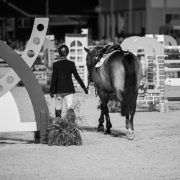Power in Numbers: The Secret Sauce Of Adult Amateurs

It didn’t take Mary Babick long to admit that the U.S. Hunter Jumper Association is having an identity crisis.
In her “state of the association” speech at the organization’s annual meeting last month, the president of USHJA warned a conference room full of trainers, professionals, and clinicians that there are challenges ahead.
“We can’t be willing to accept the status quo,” she said at the beginning of her passionate speech. “We are way overdue for a hard look at our sport.”
The problem? The hunter/jumper world is losing its base. And that base isn’t what you think it is.
For too long, the sport has catered to professionals – the riders and trainers competing at the top levels of the sport. Somewhere along the way, Mary said, the USHJA began to lose sight of the sport’s largest population: adult amateurs.
“Adult amateurs make up our largest group of members, and they are also our most under-served group of members. We have to start considering their needs. If we don’t start doing that, then we’re foolish.”
Now, Mary’s known to be a pretty straight shooter. The few times I’ve interviewed her myself, I was impressed by her willingness to get straight to the problem and how she plans to fix it. There’s no sugarcoating or skirting around the issues with her.
Read This Next: Is Horsemanship Dead?
Some may remember how she tackled the drug issue that’s been haunting the hunter world front-facing. She immediately set up a task force and posted about it at length on her personal Facebook page.
So at the annual meeting, Mary skipped ahead to a PowerPoint slide that showed the breakdown of current USHJA 45,000 members. Now remember, the USHJA is an American-only organization. And it caters partially to sports only found in North America: hunters and equitation. But it’s still the largest among the affiliate organizations underneath the USEF, even if it’s only 14 years old, Mary said.
And there’s no denying its largest population is by far, the adult amateur category.
“This is why we don’t have a middle or a bottom anymore,” Mary explained about the organization’s membership. She added that the group’s smallest population are pros. “If we don’t start focusing our effort, we’re not going to be able to stay relevant.”
Like other horse sport organizations, the USHJA manages plenty of programs that are tailored to identifying and cultivating young talent that could go all the way to the top of the sport. But where does that leave amateurs, who are just as passionate, but treat their competition goals as more of a hard-earned hobby rather than an all-consuming athletic endeavor?
That’s the USHJA’s challenge right there: coming up with programs that matter to adult amateur riders.
Mary had some half-formed ideas, like expanding the USHJA’s Horsemanship Quiz Challenge to adults. The organization also touted its AON/USHJA National Championships show in Las Vegas, which drew a crowd of amateurs, who could compete in friendly 2-foot and 2’6″ height divisions.
But Mary encouraged members to reach deeper. How could sport organizations like the USHJA better serve adult amateurs? As an “adult ammie” myself, I see the value in investing in this segment of the horse enthusiast population. We do this out of the love we have for the sport and our animals, not for any monetary gain. From the sport’s perspective – we’re their biggest, and mostly untapped, customers. We show, we have spending power, we travel to be merely spectators at big equestrian events.
Why wouldn’t you cater more to our market to keep us engaged?
“We’ve come a long way, but we have a lot more territory to cover,” Mary said, in closing. “Horse people are strong. We’re resourceful and we’re resilient. We are experts at convincing a 1,200-pound animal that we are more powerful than they are. It’s time to harness that energy and spirit and take a step into our future.”
I’ll be very curious to see just how important adult amateurs are to this sport in the future.


